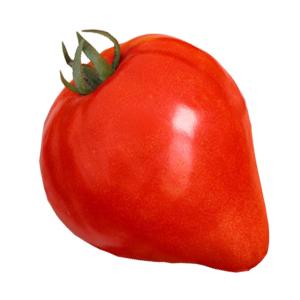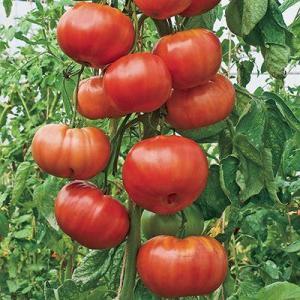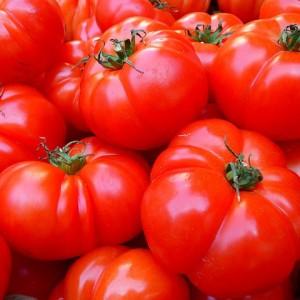Many argue about whether a tomato is a berry or a vegetable: let's figure it out together and consider different points of view
“Red, tasty, though not sweet. It matures in an ordinary garden bed ... ". Who among us in childhood did not guess the riddle about a tomato? But what about the respected Signor Tomato from the famous fairy tale by Gianni Rodari "The Adventures of Cipollino"? This fruit is known everywhere, sauces and salads are made from it, used as a cosmetic product, canned for the winter.
Gardeners around the world cannot imagine their garden without tomatoes or tomatoes. Have you ever wondered what is the difference between them? And in general, is a tomato a berry or a vegetable? Or maybe a fruit?
The content of the article
What is tomato
Let's try to resolve the centuries-old dispute and figure out what this plant is.
Tomato from different angles
There are three theories about product category:
- botanical;
- culinary;
- household.
According to the first theory, tomatoes belong to berries, because in botany, this term refers to a fruit with juicy pulp, thin skin and the presence of seeds.
Culinary theory says it's a vegetable. Everything is clear here: we use it mainly when cooking meat, fish, vegetable salads.
The everyday point of view says that the tomato is cultivated as a vegetable plant. In conversations with each other, people are used to understanding a tomato as only a vegetable, and not a fruit or berry.
Interesting! In English, there is no difference between the words "fruit" and "fruit". At the end of the 19th century, the American Supreme Court ruled that the tomato should be considered a vegetable, since it was served mainly for lunch and not for dessert. Although the court also noted that from the point of view of botany, it is still a berry.
How tomatoes came about and why the controversy arose
Peru is considered to be the birthplace of the plant. According to archaeological data, ancient people bred this culture as early as the 5th century BC. Gradually, it spread throughout the world. Columbus brought it to Europe in the 15th century. It is assumed that the reason for the dispute about whether it is a vegetable or a fruit lies in the name of the plant.
At the end of the 15th century in France, Belgium, Italy and Spain, the tomato was called the "apple of love". In the Czech Republic and Hungary, it was called the "heavenly apple". It is understandable: round red fruit, pulp inside. Hence, numerous theories and names appeared.
Appearance in Russia
For our country, tomato is a relatively new plant. They began to grow it only 3 centuries ago. Empress Catherine II liked the taste and appearance of the tomatoes so much that she ordered Italian tomatoes to be regularly delivered to the imperial table. In many homes, the plant was grown as an ornamental crop.
If a tomato is a fruit, then why?
Europeans call fruit soft juicy fruits. This is the only reason why a tomato can be called a fruit plant.
In our country, they are skeptical about this: we do not add tomatoes to sweet dishes, do not pour ice cream over them with juice, do not treat children as sweets. Therefore, for our country, a tomato is exclusively a vegetable.
History of tomatoes
In addition to the generally accepted point of view, some scholars consider not only Peru to be the birthplace of culture, but also Mexico and South America. Indians also grew tomatoes, calling the plant "tumatl". From this it becomes clear why today the culture is called "tomato".
Some information from botany
Initially, botanists attributed the plant to the nightshade family.It is known for its poisonous properties, so for a long time tomatoes were considered a poisonous crop. In fact, fruits and seeds do not pose any threat to life and health.
Interesting! There is a legend that during America's struggle for independence, George Washington's chef wanted to poison the president with a "poisonous" dish - meat and tomatoes. The president was pleased with the dinner, and the cook cut his throat, as he was afraid of reprisals for the crime.
Today, botanists call the tomato a multi-star syncarpous berry. However, it is grown as a vegetable. Tomatoes are harvested after a short cultivation and loosening of the soil. Gardeners are very fond of tomatoes - there are already about 500 varieties.
Interesting Facts
The history of the origin and spread of culture has overgrown with myths and legends, as well as scientifically proven interesting facts:
- Colonel Robert Johnson managed to prove that tomatoes do not pose a threat to people, who in 1820 ate a whole bucket of tomatoes in front of a courthouse in New Jersey. The audience saw that everything was fine with him, and since then they stopped treating tomatoes as a poisonous plant.
- As soon as tomatoes were called in different countries: in Germany - "heavenly apple", in France - "apple of love".
- There is a tiny tomato in nature. Its size is only 2 cm in diameter.
- China is the world leader in tomato cultivation.
- Besides red, tomatoes come in black, yellow, and pink.
- There is no cholesterol in tomatoes, but there are many useful elements, for example, vitamins A and C, fiber.
- Tomatoes are said to improve mood because they contain the "happiness hormone" serotonin.
- Heat treatment only improves the quality of the fruit.
- It is better to store tomatoes in a warm place, as low temperatures spoil them faster.
- Doctors say that regular consumption of tomatoes reduces the risk of cancer.
- For a long time, tomatoes have been used as decoration for gardens.
- When tomatoes were just brought to Russia, they were called “mad berries” and “sinful fruits”.
- Tomatoes slow down skin aging. This is due to the fact that they contain the pigment lycopene, the highest content of which is observed not in fresh vegetables, but in tomato paste or juice.
- The statement that tomatoes are an aphrodisiac is incorrect.
What is the difference between tomato and tomato
Tomato is a vegetable and tomato is the fruit of a tomato. From this it follows that it is correct to say "tomato sort" and not "tomato sort". In everyday conversation, there is no difference between tomato and tomato.
If the cookbook says "two tomatoes" or "two tomatoes", you will still have one picture in your head - a spherical red fruit. The same can be said for tomato juice and tomato paste.
Tomatoes in medicine and in everyday life
 In addition to its bright taste, the plant is widely popular in folk medicine. For medicinal purposes, not only fruits are used, but also stems. The infused leaf bath has an effective anti-inflammatory effect on the feet.
In addition to its bright taste, the plant is widely popular in folk medicine. For medicinal purposes, not only fruits are used, but also stems. The infused leaf bath has an effective anti-inflammatory effect on the feet.
Daily use of freshly squeezed tomato juice strengthens the immune system, and also helps to cope with stomach diseases, normalizes metabolism.
In addition, tomato is considered an excellent cough remedy. You just need to chop the vegetable, mix it with garlic and use it with meals.
Important! Tomato fruit is an allergenic product. If you have a predisposition to allergies, eat tomatoes with care. Doctors advise to be attentive to people who have problems with the liver and gallbladder. And if a person suffers from arthritis, then the use of this product must be completely abandoned.
In cosmetology
With the help of this plant, they get rid of wen, for which the skin is treated with a piece of vegetable. Tomato also gives the skin a healthy complexion and protects it from the sun's rays. The fruit is used in the manufacture of cosmetic creams: it has an antioxidant effect and anti-aging effect, smoothes wrinkles and reduces pores.
Green tomato is actively used in cosmetology. Thanks to its properties, it helps to reduce inflammation and itching, accelerate skin recovery and heal scars.
In other words, the plant has rich reserves of vitamins and useful elements. Regular use of the product has a beneficial effect not only on the internal organs, but also improves the condition of the skin.
Read also:
Conclusion
A tomato can be called a fruit, a vegetable, or a berry. Also, you can't go wrong if you say that tomato and tomato are one and the same. In everyday life, there is no difference between them. For the first time the culture appeared in ancient Peru, and over time it spread throughout the world. It is surprising that at first the plant was considered poisonous and was used only as a decorative element.
Today it is difficult to imagine a vegetable garden without tomatoes. People love this vegetable, add it to salads, soups, boil tomato paste and canned tomato juice. The product also has beneficial anti-aging properties: it improves skin color and cleanses the body. However, do not forget that tomatoes are dangerous for allergy sufferers and should be consumed in moderation.